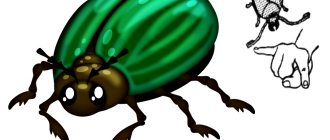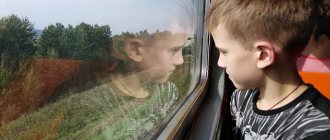Animal Tales
Realistic animal behavior and an interesting plot captivate children into a magical world. Over time, characteristics developed that became inherent to a particular animal. A kind and strong bear, a cunning fox, a simple-minded and cowardly hare. The humanization of animals has given them individual traits that are easily remembered and recognized by children.
It's quite easy to come up with a fairy tale about animals. You need to choose the main character and several episodes that happened to him.
Children from 5-6 years old can compose fairy tales on their own. At the first stage, an adult helps them. Gradually, the child himself begins to choose the main character and the situations that happened to him.
Child from one to two years old
At the age of one to one and a half years, the complete unity of the baby with his mother explodes from the inside. Two independent people appear: the baby and the mother. The crisis of the first year of life lies in the child’s awareness of this change. At this age, the little person acquires a certain degree of independence: the first words, the first independent steps, the first conscious actions with objects. However, the baby's range of capabilities is still very limited.
At this age, the child’s words are still situational. His speech is already a means of communication and expression of desires and emotions. At the same time, it is still devoid of constant meanings - the same word or combination of sounds can be used to name a wide variety of objects, actions or phenomena.
The child himself is not able to find out how to properly use this or that object. How to hold a spoon? How to put on glasses? How to use a comb? Therefore, in almost every action that a child performs with this or that object, there is, as it were, an adult who shows and explains to the child the essence of the object. Therefore, communication at this age becomes a form of organizing objective activity . It continues to develop extremely intensively and becomes not only emotional, but also verbal.
A fairy tale for a child from one to two years old becomes longer in time. The story can last as long as it takes to study an interesting subject; the plot includes the active actions of the child himself. The game can be completed at any time as soon as the little listener has lost interest, and can be returned to it another time when a mutual desire arises.
Through fairy tales, norms of behavior, necessary self-service skills, as well as a general broadening of one’s horizons can be taught. At this age, fairy tales associated with certain rituals may appear. For example, a fairy tale that accompanies the process of brushing your teeth.
Once upon a time there lived little teeth in a house-mouth. And there were them... Open up, little house mouth! ... one, two, three, four, five, six, seven... The teeth decided to invite a brush to visit them. And the brush called with it some paste and a glass of water. They came and began to greet each tooth, the brush rubbed each one with its bristles on one side and the other, and on the back too. The teeth are ticklish and they laugh. After the brush came some water and rinsed each tooth. The teeth became clean and shiny. This is where the fairy tales end, and the one who listened will have strong and healthy teeth!
Secret 4. How to make a homemade book with a children's fairy tale?
I always put children's fairy tales into homemade books. I fold the album sheet in half. It turns out to be a “book” of 4 pages. The first page is the cover. A child draws it. On the cover we sign the name of our fairy tale. We make sure to choose a title that makes it clear what the fairy tale is about. The next three pages are the fairy tale itself: its beginning (second page), middle (third page) and end (fourth page). I write the text at the bottom of the page from dictation. And the child draws pictures.
The child quickly forgets his actions, especially his words. Speech is generally a phenomenon that cannot be touched, stroked or felt in any way. Such books show the child the visual result of his speech, his efforts and arouse great interest among all children. After all, this result is beautiful, you can show it to a friend, dad, grandma, stroke it, touch it!
Honestly, I have not seen a single small child who would refuse to compose a fairy tale and publish his own book based on it, in which he will be both an artist and a writer. Moreover, even the most active and hyperactive preschoolers are ready to engage in this exciting activity for hours!
Entry Fourth... and the last one this time.
You are confusing, Purity of the Unopened Leaf...
Many of us have a fear of the “blank page”... That is why even many genius writers write on unimaginable scraps of paper - on napkins, receipts...
To overcome this fear, the sheet needs to be stained... with scribbles. That is why, by the way, the drafts of many geniuses are full of drawings in the margins.
Place your pen on a blank sheet of paper and begin to draw intricate lines, shading the sheet, as very little children do.
At some point, your hand will want to stop on its own. Look at this "drawing". Try to see something meaningful in it. Write down any associations that arise.
Now (without stopping!) start writing coherent sentences about these associations.
Owl Council
The Fox realized that she would remain a girl. Only she had no idea why all the noble suitors were avoiding her. Then she went to the wise Owl to ask for advice. “Uh-uh, uh-uh!” - the Owl screamed on the branch. “Hey, wise mother! - The Fox turned to her in a humble, thin voice. “I wanted to ask you for advice on how I, the red Fox, can avoid being lonely.” “Okay, gossip, I’ll give you some instructions now. If you follow my advice, you will forget about sadness and melancholy and you will find yourself a groom in an instant.” “Okay, Sovushka, I’m listening to you carefully!” - answered the Fox. The interlocutor answers her: “Go, Fox, to the distant lake, to the forest, to the neighboring village. There you will see a bast hut, decorated with paints and flowers. Knock on it three times, and when the occupant of the hut comes out, ask him to spend the night. And if you’re smart enough, then sell the chicken you caught the other day, and at a higher price. This is how you will understand whether others want to do business with you.”
Sunset Second
If games with words do not impress you (because you are in an excited stressful state, for example), then the following technique will help you write your fairy tale. Think about it: what topic would you be interested in talking about right now?
Let the “working” theme of the fairy tale be the problem that you have been scrolling through in your head lately. No money? Doesn't your loved one call? Years go by? Children don't listen?
Once you start writing a story about a topic that is important to you, you may suddenly discover new ways to make money, a new perspective on your relationship with your loved one, and a new perspective on your relationship with your children...
All your worries and sorrows can (and should!) become the theme of your psychotherapeutic fairy tale!
How the Fox was fooled
Then the gate opened, and the owner of the bast hut, the Fox, came out. “Why, redhead, are you lost in the forest? Why didn’t you spend the night at home?” The fox answers: “I went hunting, but I hesitated in catching a purebred guinea fowl. Now it’s too late for me to return home. If you let me into the yard, I’ll sell you my loot at a good price.” “And what will your price be, gossip?” “For ten gold pieces I’ll give you the whole thing, plus a cabbage leaf,” answered the Fox. “Okay, then come in,” answered the Fox. The redhead went into the bast hut, where the stove was just flooded. And she was so exhausted that she fell asleep right there on the bench.
In the morning the Fox woke up, and meanwhile the Fox was taking care of the housework and getting ready to hunt. “What is the owl science here?” — the redhead began to think. And the Fox says to her: “Well, if you’ve had enough sleep, godfather, then drink milk from the jug to the bottom. And pack your knapsack and leave the hut already - it’s time for me to go hunting.” “What about the chicken?” - asked the Fox. “And keep your prey for yourself, you see, I am a noble Fox, always ready to shelter a wanderer.”
The fox went home. Look along the road - there is no guinea fowl in her knapsack. There are no morocco boots either - she has birch bark sandals on her feet. The deceived gossip said to herself: “Why did I have to deal with this Fox?” It was then that she remembered the words of the wise Owl, and the Fox began to work on correcting her character.
Entry First
Come up with ten words - ten common nouns, maybe phrases (table, chair, lamp, window, tin can, sweet pea...)
Let these words be taken by you from various areas of life. (prairie, general secretary, carnival, ball, cod)
Now words can be bent, rethought and turned inside out. How? That's how!
Let's say you came up with the words: Hedgehog, already, goal, ram...
We bow the word “Hedgehog”. The first thing that comes to mind is “hedgehog.” From this word you can make the word “already” by reading it backwards!
The word "goal" can be reversed to become "log".
A fairy tale may begin like this: “Once upon a time in the forest there lived a young hedgehog named “Baran.” Wherever he went, other hedgehogs said to him: “Where are you going, sheep? Can’t you see that my hedgehog is bathing naked here, you’re embarrassing her. And here we have mosquito nets set up. You'll trample them all now. Watch where you're going, sheep!
And so it happened. One day, a Ram (that is, a hedgehog) wandered into a damp ravine, in which the old Uzh was sitting out the heat...
And so on...
This technique is good for those who like to play with words, twist them this way and that, find endless meanings even in one short word.
Child up to six months
Babies of this age are in inextricable unity with their mother. Only if there is close spiritual and physical contact with her, the social situation will be comfortable for the child.
The main, leading type of activity of a child in infancy is direct emotional communication , the subject of which for the child is an adult. The first social need that is formed in a child is the need for another person, the development of which parents need to pay special attention to: they need to talk to the child, smile, tell him fairy tales. The baby still does not understand everything that an adult tells him, but this should not be a reason for embarrassment. Psychologists say: “A baby is helpless if he is alone, but a pair of “mother and child” is not only not helpless, but amazes with its vitality.”
A fairy tale that a mother tells a child of this age can be called a fairy tale only conditionally, because its plot is absolutely not important for the child. A fairy tale becomes one of the components of complex contact with a child. Here, the mood, emotional state, and intonation pattern of the narrator’s speech acquire special significance, because through intonation the child “absorbs” the adult’s state and feels his attitude towards himself. The words can be anything; as a rule, the words reflect some kind of interaction with the child.
For example, when doing gymnastics:
Let's stroke the arms up and down, up and down, stroke the legs up and down, up and down, and now the tummy - in a circle left and right. Let's catch mom's fingers: grab-grab-grab! We wave our arms forward, up and to the sides. Who is mom's athlete? Forward, upward and sideways.
This fairy tale game does not have a clearly defined beginning and end, so it can last as long as the game is interesting to the child.
Speech is accompanied by appropriate movements, the contact between mother and child becomes complex: the baby sees the mother, hears the intonation of her voice and feels touch. Thus, the inextricable unity of mother and baby is achieved, which is so necessary for a child of this age.



